How to improve my dog’s breath? Ever smelled your dog’s bad breath? You’re not alone! Many dogs face dental problems early in life, leading to bad breath. Poor oral care, some health issues, and certain foods can also cause this problem.
Thankfully, there are ways to help improve your dog’s breath. Regular dental check-ups, brushing their teeth daily, and giving dental chews can boost their oral health.
A balanced diet and plenty of water also help keep your dog’s breath fresh. By reading today’s article and following our tips, you can prevent dental issues and promote better breath for your furry friend.
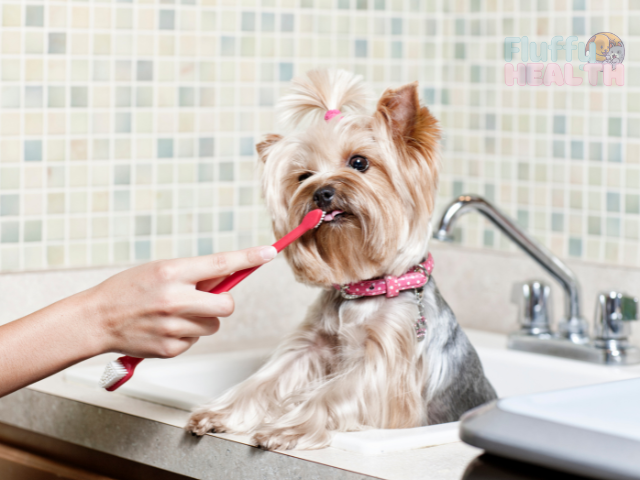
Table of Contents
Understanding the Causes Of Bad Dog Breath
As a loving dog owner, you might have noticed your dog’s breath isn’t always fresh. Bad breath, or halitosis, is common in dogs. Knowing why your dog has bad breath is important to treating it and keeping their teeth and mouth clean.
Dental Diseases
Dental problems cause bad breath, or halitosis, in dogs about 80% of the time. One serious issue is periodontal disease, which causes swollen and infected gums and can harm the teeth. Almost 80% of dogs show signs of periodontal disease by the age of two, so early care is very important.
As a dog owner, you should provide regular dental care at home, including brushing your dog’s teeth and giving them dental chews or toys to reduce plaque. Regular visits to the vet are also essential for professional exams and cleanings. Most vets suggest that dogs get a full dental cleaning at least once a year to keep their mouths healthy and their breath fresh.
Many vet clinics offer special deals in February, known as Dental Health Month, to encourage pet owners to take care of their dogs’ teeth. They often provide discounts on dental cleaning services, making it easier for owners to give their pets the dental care they need for a healthier and happier life.
Diet & Digestive Issues
Bad breath in dogs often comes from their diet and health problems. About 15% of dogs have bad breath because they eat bad things, like garbage or unhealthy foods. Feeding your dog a balanced diet and avoiding table scraps can help reduce bad odors.
Health issues can also cause bad breath. Diseases like diabetes and kidney disease affect around 5% of dogs and can change how their breath smells. These health problems may signal something more serious inside the dog, so getting them checked out quickly is important.
If your dog’s bad breath doesn’t improve with diet changes or you think it might be a health issue, you should see a veterinarian. A vet can look for any health problems and suggest the right treatment.
| Cause of Bad Breath | Percentage of Cases |
|---|---|
| Oral and Dental Diseases | 80% |
| Dietary Indiscretion | 15% |
| Medical Conditions (e.g., diabetes, kidney failure) | 5% |
| Oral Tumors | 3% |
| Respiratory Issues | 2% |
| Puppy Bad Breath | 1% |
Knowing why dogs have bad breath helps you help them. Clean their teeth regularly, feed them well, and check for health problems. This keeps their breath fresh and healthy.
Brush Your Dog’s Teeth Regularly
Brushing your dog’s teeth every day is the best way to keep their mouth healthy. It helps prevent bad breath, which comes from harmful bacteria in the mouth.
The American Veterinary Medical Association reports that nearly 80% of dogs show signs of dental disease by age three. This can lead to serious problems, like pain and infections, affecting their overall health.
By brushing regularly, you can lower the risk of dental issues, keep your dog’s breath fresh, and improve their quality of life. To make brushing easier and more effective, use toothpaste made for dogs and a soft-bristled toothbrush designed for pets.
Even brushing a few times a week is good for your dog’s teeth. Vets say brushing regularly is key. It stops plaque and tartar from building up.
Choosing The Right Toothbrush & Toothpaste
Choosing the right tools to clean your dog’s teeth is important for their oral health. Don’t use human toothpaste, as it can be harmful to pets. Instead, pick toothpaste made for dogs, like Petsmile, which is safe and effective.
Use a soft-bristled toothbrush designed for dogs. Its gentle bristles will help remove plaque without hurting their gums. Regular dental care, like brushing daily if you can, dental chews, and professional cleanings from a vet, will help keep your dog healthy. Start a good dental care routine early to make it easier for both you and your pet.
There are many toothbrushes for dogs, like:
- Finger toothbrushes that fit over your finger
- Small, angled brushes for better reach
- Double-ended brushes with different bristle sizes
- Electric toothbrushes designed for pets
Techniques For Brushing Your Dog’s Teeth
To keep your dog’s teeth healthy, brush them gently in a circular motion, especially along the gum line where bacteria can build up. Be patient, as your dog may need time to get used to this.
Here are some tips to make brushing easier and more effective:
- Introduce Toothpaste Slowly: Let your dog taste dog-safe toothpaste first. This helps them see it as a treat. Never use human toothpaste, as it can be harmful.
- Use Positive Reinforcement: Give your dog treats, praise, or hugs during brushing. This makes them more likely to cooperate. You can also reward them with a favorite toy afterward.
- Choose the Right Time: Brush when your dog is calm and relaxed, like after a walk or playtime. This will help them stay still while you brush.
- Create a Routine: Make brushing a regular part of your dog’s day at the same time each day. This helps your dog get used to it and feel less anxious.
- Use the Right Tools: Get a soft-bristled toothbrush for dogs or use finger brushes for better control. Make sure the brush fits your dog’s size.
- Watch Their Oral Health: While brushing, look for signs of dental problems, like swollen gums, bad breath, or discolored teeth. If you see anything unusual, talk to your veterinarian.
Brushing your dog’s teeth regularly can help prevent dental diseases and keep their breath fresh. A little effort goes a long way in keeping your pet healthy and happy.
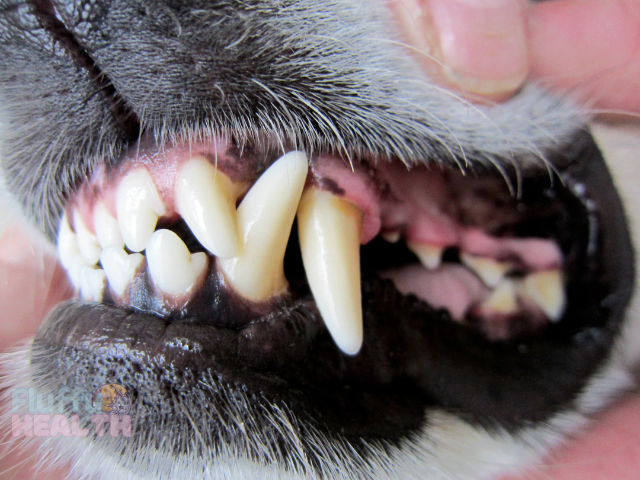
Provide Dental Chews & Toys
Regular brushing is key for your dog’s teeth. But, dental chews and toys also help keep their mouth clean. They cut down on plaque and tartar. Studies show dental chews can reduce these by 20–30%.
Choose dental chews with the Veterinary Oral Health Council (VOHC) approval. These products must cut plaque or tartar by at least 10%. Those with chemical agents need to reduce it by 20%.
Here are some good dental chew options:
- Greenies’ chewy dental treats, priced at $33.98 from Chewy
- BARK Bright dental chews, which include an enzyme toothpaste with 3 types of active enzymes and offer a monthly supply for $30/month
- Whimzees chews, which are all-natural, non-GMO, and priced at $30.89 on Amazon
Some rubber toys, like the Kong Extreme, can hold treats or toothpaste. As your dog chews, their teeth and breath get cleaner. Rawhide bones also fight plaque, but take them away when they get soft to avoid choking.
| Product Feature | Impact on Dental Health |
|---|---|
| Increasing kibble diameter by 50% | 42% reduction in tartar |
| Coating pet dental products with polyphosphate | 55% further reduction in tartar |
Dental chews and toys are great for your dog’s teeth. But, remember to brush their teeth regularly and take them to the vet for dental cleanings. If your dog has bad breath, swollen gums, or other dental issues, see a vet.
Feed A Balanced & Healthy Diet
It’s important to give your dog a healthy diet. This helps keep their teeth and gums strong. It also helps fight bad breath.
Avoid Table Scraps & Human Food
It’s best not to give your dog human food because it can cause bad breath and health problems. Many human foods are harmful to dogs. For example, chocolate contains theobromine and caffeine, which can be toxic in small amounts.
Grapes and raisins can also cause kidney failure in dogs, even if they eat just a little. To keep your dog healthy, stick to food made for them, and talk to your veterinarian if you’re unsure about what foods are safe.
Choose High-Quality Dog Food
Choose dog food that is good for your pet. Look for options with real meat and avoid those with harmful ingredients. Foods that include whole grains and fruits are also great choices.
Here’s what to look for in dog food:
- High-quality, lean protein
- Whole grains for extra fiber and nutrients
- Fruits and vegetables for important vitamins and minerals
- No artificial colors, flavors, or preservatives
- Dental health formulas to help reduce plaque and tartar
Some dogs like yogurt, which has good bacteria that helps with digestion. Be careful and watch for signs of lactose intolerance.
| Dog Food Type | Benefits for Fresh Breath |
|---|---|
| High-quality, lean protein | Provides essential nutrients without excess fat that can contribute to bad breath |
| Whole grains | Fiber and nutrients support digestive health and freshen breath |
| Fruits and vegetables | Vitamins and minerals promote overall health and fresh breath |
| Dental health formulas | Helps reduce plaque and tartar buildup, preventing dental issues and bad breath |
Feeding your dog well helps them have fresh breath. However, always talk to your vet if you’re worried about their breath or teeth.
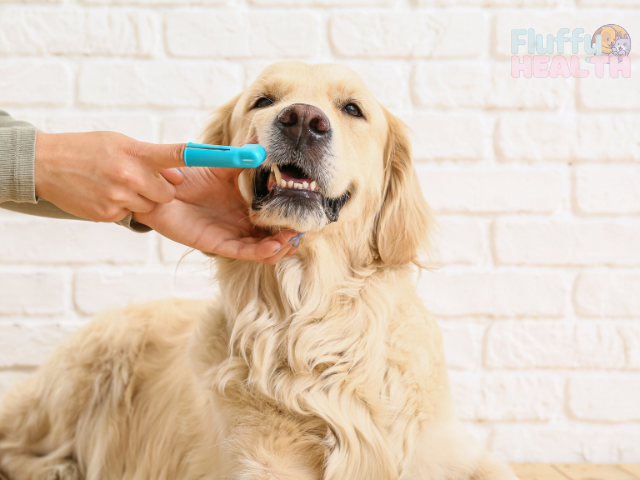
Use Natural Breath Fresheners
You can use natural remedies from your kitchen to fight your dog’s bad breath. These natural options not only help remove bad smells but also support your dog’s health.
For example, parsley can help with digestion and reduce odors, while carrots can clean your dog’s teeth as they chew. Adding these foods to your dog’s diet or giving them treats can improve their breath and oral health. Choosing these natural solutions improves your dog’s breath and contributes to its overall well-being.
Parsley
Parsley is great for freshening your dog’s breath. It’s full of chlorophyll. Add about one teaspoon of chopped parsley for every 10 pounds of your dog’s weight to their food.
Coconut Oil
Coconut oil is also good for your dog’s breath. It keeps their breath fresh and offers health benefits. Put a little coconut oil in their food bowl or use it as toothpaste.
Apple Cider Vinegar
Apple cider vinegar kills bacteria that cause bad breath. It’s a natural disinfectant. Add a teaspoon to their water bowl each day to freshen their breath.
Cinnamon
Cinnamon is tasty and freshens breath. It breaks up food particles and stops bacteria. Sprinkle a bit on their food to keep their breath smelling good.
| Natural Breath Freshener | Amount | Application |
|---|---|---|
| Parsley | 1 tsp per 10 lbs of body weight | Add to food |
| Coconut Oil | Small amount | Add to food or use as toothpaste |
| Apple Cider Vinegar | 1 tsp per day | Add to water bowl |
| Cinnamon | Small amount | Sprinkle on food |
Using these natural dog breath fresheners can help fight bad breath. They also improve oral health. Just remember to use them in small amounts. Always talk to your vet about your dog’s dental health.
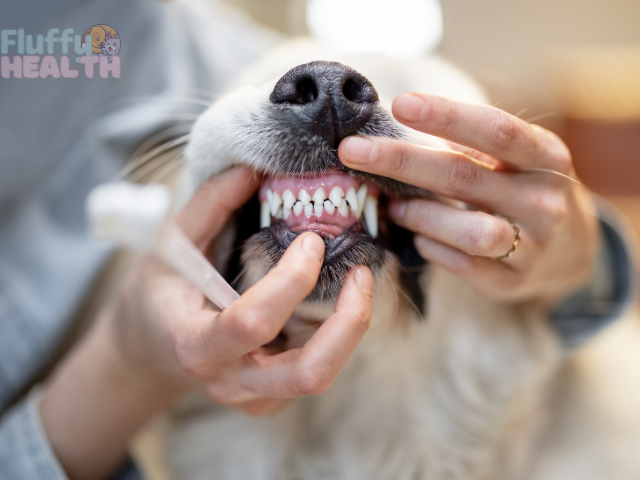
Offer Fresh Water & Encourage Hydration
It’s very important to make sure your dog always has clean, fresh water. This is important for their health and helps keep their breath fresh. Drinking enough water helps clean their mouth and teeth.
To help your dog drink more water and keep their teeth clean, try these tips:
- Put water bowls all over your house so your dog can drink whenever they want.
- Change the water in the bowls every day to keep it fresh and tasty.
- Put a little bit of low-sodium chicken or beef broth in their water to make it more fun to drink.
- Give your dog hydrating treats like frozen broth cubes or watermelon chunks for a tasty drink.
Dogs can get very thirsty in hot weather. So, it’s important to watch how much water they drink. When it’s hot and they’re active, they need even more water to stay healthy.
| Dog Size | Daily Water Intake |
|---|---|
| Small (up to 20 lbs) | 1-2 cups |
| Medium (20-50 lbs) | 2-4 cups |
| Large (50-90 lbs) | 4-7 cups |
| Giant (90+ lbs) | 7+ cups |
Make sure your dog always has fresh, clean water to drink. This helps keep their breath fresh and their teeth clean. Taking them to the vet regularly can also help find any health problems that might cause bad breath.
Schedule Regular Dental Check-Ups With Your Vet
Taking your dog for regular dental check-ups is important for their health. During these visits, your vet will check your dog’s teeth and gums for signs of dental problems, plaque, or gingivitis. They will also look at your dog’s breath, as bad breath can mean health issues.
The American Veterinary Dental College says that more than 80% of dogs will have some dental problems by the time they are three years old. If these problems are not treated, they can lead to serious health issues, including heart, liver, and kidney problems.
Regular dental check-ups help prevent these issues and keep your dog’s teeth healthy. By making these visits a priority, you support your pet’s quality of life.
Professional Teeth Cleaning
Your vet might suggest a professional teeth cleaning for your dog. This cleaning removes plaque and tartar under anesthesia. They also check for decay, infection, or other issues.
Most vets say dogs need teeth cleanings once a year. But some dogs might need them more often. Your vet will decide what’s best for your dog.
Identifying & Treating Dental Issues
Regular check-ups help your vet find and treat dental problems. These include tooth decay, gum disease, and oral infections. They can also find broken teeth or retained baby teeth.
Your vet might suggest treatments like antibiotics or dental surgery. Early treatment helps prevent serious problems. It keeps your dog healthy and happy.
| Frequency | Recommended Dental Care |
|---|---|
| Daily | Brush your dog’s teeth with a dog-specific toothbrush and toothpaste |
| 2-3 times per week | Offer dental chews and toys to help reduce plaque and tartar buildup |
| Annually | Schedule a professional dental cleaning and check-up with your vet |
Regular dental care keeps your dog’s teeth and gums healthy. It also keeps their breath fresh. Don’t wait for bad breath, book a dental check-up with your vet today!
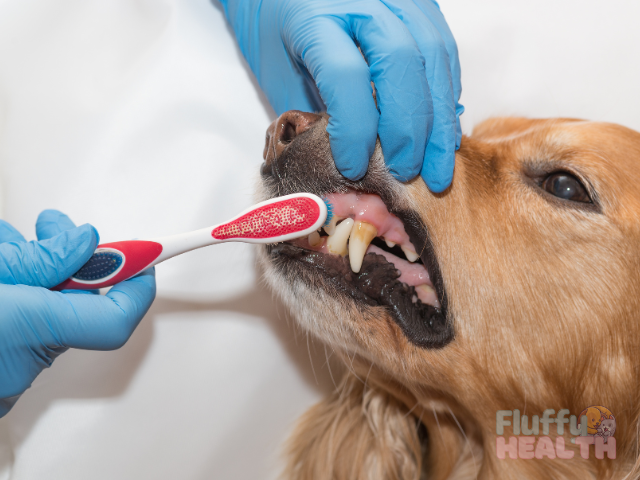
How To Improve My Dog’s Breath: A Step-by-Step Guide
Keeping your dog’s breath fresh is important for their health and happiness. Here’s a simple guide to tackle bad breath and keep your dog’s mouth clean:
- Brush Teeth Daily: Try to brush your dog’s teeth every day with a toothbrush made for dogs and dog-safe toothpaste. This helps stop plaque from building up, which can cause bad breath and dental problems. Start slowly and reward your dog with praise or a treat.
- Dental Chews and Toys: Get good dental chews and toys that help with oral health. These can remove plaque and tartar as your dog chews. Look for products with the Veterinary Oral Health Council (VOHC) seal of approval to make sure they work well.
- Healthy Diet: Feed your dog a balanced diet and avoid giving them table scraps or human food, as these can harm their teeth. Consider a dental diet designed to help clean their teeth while chewing. These often include kibble that scrubs teeth and reduces plaque.
- Natural Breath Fresheners: Use natural items to help freshen your dog’s breath. A little parsley can neutralize odors, while coconut oil can improve oral health. You can also dilute apple cider vinegar in water for your dog—but check with your vet first for the right amount. Cinnamon can help, too, but use it sparingly.
- Fresh Water: Always give your dog fresh, clean water. Drinking water helps wash away food particles and bacteria that cause bad breath. A pet water fountain might be a good choice, as many dogs enjoy running water.
- Regular Vet Visits: Take your dog to the vet for dental check-ups at least once a year or twice a year. These visits help find and treat any dental problems early. Your vet may suggest professional cleanings when needed.
Following these steps can help your dog have fresh breath and good oral hygiene, improving their health and quality of life.
| Health Condition | Breath Odor | Other Symptoms |
|---|---|---|
| Kidney Disease | Uremic breath (smells like urine or ammonia) | Increased thirst and urination, lethargy, loss of appetite |
| Liver Disease | Foul-smelling breath | Jaundice, weight loss, poor appetite, vomiting |
| Diabetes | Sweet or acetone-like breath | Increased thirst and urination, weight loss, lethargy |
| Oral Tumors | Persistent bad breath | Difficulty eating, drooling, facial swelling, bleeding from the mouth |
But remember, if your dog’s breath suddenly gets very bad, see a vet right away. It could mean a serious problem like a tooth fracture or organ failure. By taking care of their teeth and watching for health issues, you can keep their breath fresh and their health good.
Try Probiotics For Digestive Health & Fresh Breath
Did you know bad dog breath often comes from bacteria in their belly? Probiotics can help fight this and make your dog’s breath better. These good bacteria help with digestion and keep the immune system strong. They also help get rid of bad breath bacteria.
When picking a probiotic for your dog, choose a good one made just for them. Look at brands like The Honest Paws Probiotics for Dogs with Prebiotics ($29.97/month). Or try Purina Pro Plan Fortiflora Probiotic Supplement ($30.99/month). Fera Pet Organics Probiotics with Prebiotics ($28.95/4 months) is another great option.
Adding probiotics to your dog’s life is easy. You can give them pills or powders or even mix them with their food. Always follow the right amount and keep it fresh. Even though there’s not much research, many people say probiotics help a lot. They can improve your dog’s breath and help them feel better overall.
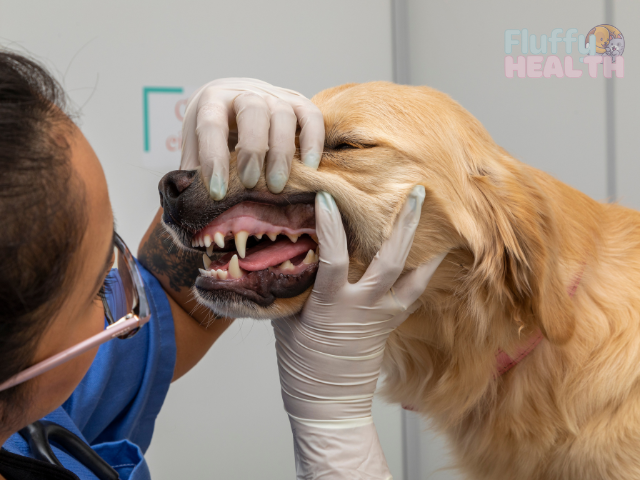
How To Improve My Dog’s Breath? The Conclusion
After answering today’s question on how to improve my dog’s breath in detail, you can see how important it is to keep checking on your dog’s mouth, teeth, and overall health. Bad breath, as we read above, can mean many things, but it is important to make sure it is nothing serious!
Keep taking care of your dog as you always do, and make sure you give your friend an extra step to keep it healthy and happy.

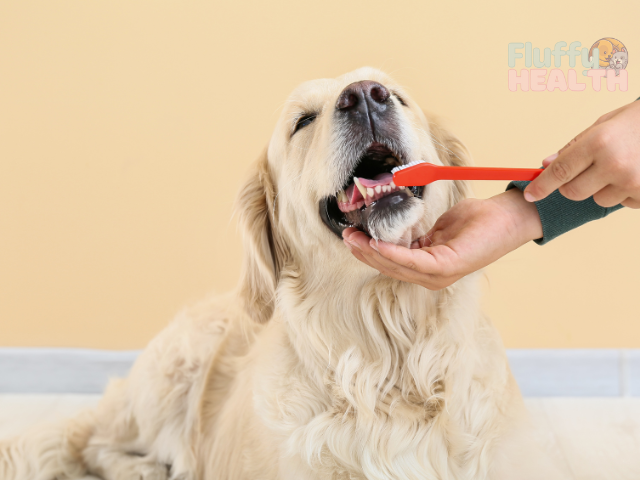
There is nothing worse than trying to have a snuggle with your furry friend, only to find that his bad breath pushes you away. It is worrying to see that about 80% of dogs show signs of periodontal disease by the time they are two years old, as I thought halitosis in dogs was predominantly in older dogs.
But it is reassuring to see that there are several ways in which a dog owner can help to prevent bad breath in their dogs. Wew have in the past regularly used dental chews for our dogs, but I will certainly follow your advise and start brushing their teeth on a regular basis.
Thank you for sharing this helpful guide.
You’re absolutely right, LineCowley, nothing ruins a good cuddle like bad breath! It’s surprising how common periodontal disease is in young dogs, but it’s great that you’ve been proactive with dental chews. They can definitely help reduce plaque and tartar. Regular brushing will complement that and make a big difference in keeping your pups’ mouths healthy.
If you haven’t already, you might also consider using dog-safe toothpaste with a flavor they like—it makes the process a bit easier (and more fun for them!). I’m so glad you found the guide helpful, and I hope these tips keep those snuggles enjoyable! Thank you for your kind words and for sharing your experience!
This is such a well-rounded and informative article. Thank you for shedding light on such an important topic for dog owners! I never realized that dental diseases account for such a large percentage of bad breath in dogs. The fact that 80% of dogs show signs of periodontal disease by age two is quite alarming, but it’s a great reminder to prioritize regular brushing and dental checkups.
I appreciate how practical your tips are, especially about choosing the right toothbrush and toothpaste for dogs. The mention of finger toothbrushes and electric brushes designed for pets was super helpful. I’ve always struggled to find the best tools for my pup.
One question I have is about diet and its role in oral health—do certain foods or treats actively help prevent bad breath, aside from dental chews? I’d love to hear more about that. Thanks for the great insights!
Thank you so much for your kind words, Kavitha! I’m glad you found the article informative and helpful. It’s great to hear that the tips, especially about the right toothbrush and toothpaste for dogs, were useful to you!
You’re absolutely right—dental care is so important for our furry friends, and it’s shocking how many dogs show signs of periodontal disease at such a young age. Starting early with regular brushing and check-ups can really make a difference.
As for your question about diet and bad breath, you’re spot on—certain foods and treats can actively help prevent bad breath. High-quality dog food with lean proteins and fiber, like whole grains, fruits, and vegetables, can aid in digestion and contribute to fresher breath. There are also specific dental diets designed to reduce plaque and tartar as your dog chews, which can be a great addition to regular oral care.
Adding natural breath fresheners, like parsley or coconut oil, to your dog’s diet can also help with bad breath, as they contain properties that support oral health. But of course, it’s always best to check with your vet to ensure these natural options are right for your dog.
Thanks again for your thoughtful comment! I hope these suggestions help keep your pup’s breath fresh and their teeth in great shape.
You have created a great website to teach us how to take care of our Fluffies. You include everything from diet and digestive issues to taking care of their teeth. I never knew you could purchase finger toothbrushes or electric toothbrushes designed for pets. I also was interested in seeing the different causes for bad breath, with oral and dental diseases causing 80%. Thank you Dr. Alkhawaldeh for such a helpful website for pet lovers like me.
Thank you so much for your kind words, katmaunz! I’m thrilled to hear that you found the information useful and that it has helped you better understand the different aspects of canine oral health. The finger toothbrushes and electric toothbrushes designed for pets can indeed make a big difference in maintaining your furry friend’s dental hygiene. It’s always great to hear that the content is helping pet owners like you take better care of their beloved companions. If you have any more questions or need further advice, feel free to reach out. Happy brushing to you and your Fluffy!
Hello Dr. Alkhawaldeh!
Such helpful tips—thank you! Freshening up a dog’s breath can feel like a bit of a mystery sometimes, but this article makes it seem so manageable. I’m curious, do you find that certain types of dog foods or treats make a big difference in breath freshness?
Also, how often would you recommend brushing a dog’s teeth to see noticeable results? I love the idea of adding natural ingredients, but I wonder if some dogs are pickier about taste. Thanks again for the advice—excited to try some of these ideas out!
Angela M 🙂
Hello Angela,
Thank you for your kind words and great questions! I’m glad you found the article useful.
You’re absolutely right—diet plays a significant role in maintaining your dog’s breath freshness. Foods that are high in quality protein and low in processed ingredients tend to produce less odor because they are more digestible and leave fewer residues that contribute to bad breath. Also, specific dental health kibbles are designed to reduce plaque and tartar build-up, which can also help keep the breath fresh.
As for brushing your dog’s teeth, I recommend starting with two to three times a week and increasing to daily brushing if possible. Regular brushing will produce noticeable improvements in your dog’s dental health and breath freshness within a few weeks. Consistency is key here!
Regarding natural ingredients, it’s true that some dogs might be pickier than others. You might need to experiment a bit to see what your dog prefers. Many dogs enjoy the taste of coconut oil and parsley, but every dog is different. Starting with small amounts and gradually increasing them can help your dog get used to new tastes.
I’m excited for you to try out these tips! Feel free to share how it goes or if you have any more questions.
This article is such a lifesaver. I’ve been struggling with my dog’s breath for a while now, and it’s reassuring to know I’m not alone in dealing with this issue. I love that the article covers so many different approaches—from diet adjustments to dental hygiene. One thing that’s made a difference for me is incorporating dental treats and chews into my dog’s routine. It’s amazing how something so small can have such a positive impact on their breath (and my sanity!).
I’ve also started brushing my dog’s teeth regularly, which felt a bit daunting at first, but it’s actually been manageable once we got into a routine. I wonder if anyone else has tried using natural remedies like parsley or coconut oil? I’ve heard they can help but haven’t given them a shot yet. I’d love to hear if anyone has experience with those! Thanks for sharing such a thorough guide—definitely bookmarking this for future reference!
Yup, bad breath can be a problem for many pets, like cats, but dogs definitely have it worse sometimes. Brushing their teeth and using natural remedies such as Parsley can be a huge help and good for avoiding unnecessary products with who knows what!
It’s funny, I’ve had Boxers for over fifty years, and back then, we didn’t even think about brushing a dog’s teeth. Nobody mentioned dental health for dogs! Now, everywhere I look, there’s talk about dental care, special chews, even dog toothbrushes. When did this become a thing? I just let my dogs chew on bones back in the day and figured that was enough.
Looking back, I wish I’d known more—dog halitosis is no joke! If I could’ve prevented that awful dog breath, I definitely would have.
Brushing a dog’s teeth is one of the most important things I learned over the years! When I was a kid, I have never imagined dogs need such help from humans. In fact, I thought brushing my dog’s teeth might be bad for them. But here we are, it is now one of the recommendations to keep their mouth clean and healthy!